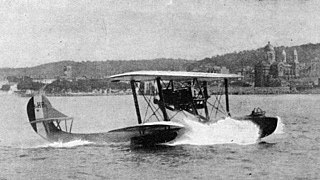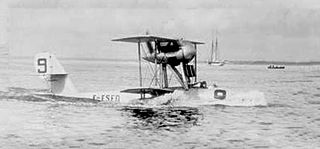Operators

- French Navy five as the HB.3
| Bellanger-Denhaut 22 | |
|---|---|
| Role | Bomber/reconnaissance flying boat |
| National origin | France |
| Manufacturer | Bellanger |
| Designer | François Denhaut |
| First flight | 1920s |
| Number built | 5+ |
The Bellanger-Denhaut 22 (sometimes known by the military designation Bellanger-Denhaut HB.3) was a twin-engined bomber/reconnaissance flying boat designed by François Denhaut the technical director for seaplanes for the car manufacturer Bellanger. [1] [2]
The B-D 22 was an unequal span biplane powered by two 260 hp (194 kW) Hispano-Suiza 8Fd inline piston engines. [2] It had an open cockpit forward of the wings for the pilot and co-pilot to sit side-by-side and gunner's positions midships and at the bow and the wings could be folded for stowage. [2] The French Naval aviation ordered five and designated them as the HB.3 although they appear to have been little used. [2] A commercial transport version was developed with the gunner's positions removed and a cabin for six passengers installed behind the pilot's cockpit. [1] [2]
Data from Illustrated Encyclopedia of Aircraft [2] , Aviafrance:Bellanger-Denhaut BD-22 [3] , Jane's all the World's Aircraft 1924 [4]
General characteristics
Performance
Armament
Related lists

The Blanchard Brd.1 was a French reconnaissance flying boat, to the 1923 STAé HB.3 specification, used by the French navy in the 1920s. It was a large biplane with two engines mounted in the gap between the wings, each engine driving a pusher propeller. In 1924, one Brd.1 was used to set several world altitude records for seaplanes.

The Blériot Bl-115 was a French biplane airliner of the 1920s, best remembered for the part it played in the French exploration of Africa. For its day, it was a large aircraft, mounting one pair of engines on the upper wing and one pair on the lower. First flying on 9 May 1923, the prototype crashed on 23 June, killing its pilot, Jean Casale.

The Blériot 127 was a French bomber aircraft of the 1920s and 1930s, developed from the Blériot 117 escort fighter. It was a large monoplane of conventional configuration that featured open gunner's positions in its nose and at the rear of its two underwing engine nacelles. The wing airfoil was of sufficient thickness that these latter positions could be accessed from the fuselage in flight.

The Breda A.4 was a biplane trainer produced in Italy in the mid-1920s. It was of conventional configuration with a two-bay unstaggered wing cellule and seating for the pilot and instructor in tandem open cockpits. Apart from civil use, the A.4 was also adopted by the Regia Aeronautica as a trainer. At least some examples were produced in floatplane configuration as the A.4idro.

The Comte AC-3 was a 1920s Swiss bomber/transport aircraft produced by Flugzeugbau A. Comte.
The Farman F.51 was a 1920s French maritime reconnaissance flying boat designed and built by Farman. The F.51 was an unequal-span four-bay biplane flying boat with a crew of four. It was powered by two Lorraine 8bd engines mounted in tractor configuration. A pusher engined version was designated the Farman F.50 . Tested by the French Navy but it failed to win any orders, Farman did briefly consider a civil version but the project was abandoned.
The Donnet-Denhaut flying boat was a maritime patrol and anti-submarine warfare aircraft produced in France during the First World War. Known at the time simply as "Donnet-Denhaut" or "DD" flying boats, the DD-2, DD-8, DD-9, and DD-10 designations were applied retrospectively to denote the various changes in configuration made during their service life.
The Loening M-8 was a 1910s American fighter monoplane designed by Grover Loening and built by his Loening Aeronautical Engineering Company. An order of 5000 for the United States Army Air Corps was canceled when the First World War ended.

The FBA Type H was a French reconnaissance flying boat produced in large numbers in France and Italy during World War I by Franco-British Aviation.

The Nieuport-Delage NiD 42 was a fighter aircraft built in France in the early 1920s, the first in a family of designs that would form the backbone of the French fighter force over the next decade.

The CAMS 31 was a 1920s French single-seat fighter biplane flying-boat designed and built by Chantiers Aéro-Maritimes de la Seine (CAMS).
The Bréguet 790 Nautilus was a prototype French three-seat coastal patrol flying-boat designed and built by Bréguet Aviation to meet a requirement from the French navy.
The Borel-Odier Bo-T was a French twin-engined float biplane designed by Borel but built by Antoine Odier for the French Navy.

The CAMS 38 was a French single-seat racing flying-boat designed by Rafaele Conflenti and built by Chantiers Aéro-Maritimes de la Seine (CAMS) for the 1923 Schneider Trophy race. The CAMS 38 was withdrawn from the race during the second lap.

The Bernard H.V.120 was a 1930s French racing seaplane designed and built by Bernard to compete in the Schneider Trophy race. Delays caused by engine problems and the crash of the second aircraft delayed entry and the aircraft did not race in the competition.

The CAMS 36 was a 1920s French flying boat designed and built by Chantiers Aéro-Maritimes de la Seine. It was originally conceived as a single-seat fighter but evolved as a racer to compete in the 1922 Schneider Trophy race. Lack of funds in 1922 and an accident in 1923 meant the two aircraft built failed to participate in a Schneider race.

The Nieuport-Delage NiD 43 was a single engine, two seat biplane fighter aircraft designed and built for shipboard use in France in 1924.

The Wibault 8 or Wib 8 Simoun (Simoon) was a tandem seat, parasol wing fighter aircraft designed and built in France to a 1925 specification which was later withdrawn; only one Wib 8 was completed.

The Les Mureaux 3 C.2 and Les Mureaux 4 C.2 were French two seat, parasol winged fighters, flown in 1927-8, which differed only in their engines. They were developed into near identical army co-operation types, the ANF Les Mureaux 130 A.2 and ANF Les Mureaux 131 A.2, in 1929-31.
The Blériot 73 was a large First World War French heavy night bomber designed and built by Blériot to the BN3 specification. Only a single prototype was built, which crashed on landing from its first flight, killing the pilot. The Blériot 74, Blériot 75 and Blériot 76, respectively, a heavy bomber / airliner, airliner and heavy bomber, directly evolved mfrom the Blériot 71 / Blériot 73 bombers.